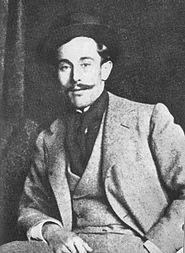Paul Albert Laurens
| Paul Albert Laurens | |
|---|---|

Photograph from 1893
(Fondation Catherine Gide) |
|
| Born |
Paul Albert Laurens 18 January 1870 Paris, France |
| Died | 27 September 1934 (aged 64) Toulon, Department of Var |
| Nationality | French |
| Known for | Painting, drawing |
Paul Albert Laurens (18 January 1870 - 27 September 1934) was a French painter.
Laurens was the eldest son of painter Jean-Paul Laurens (1838-1921), who was of humble origins, and his wife, Madeleine Willemsens (1848-1913). Laurens was born in Rue Taranne, off the Boulevard Saint-Germain in Paris, to where his parents had moved. Aware of the Franco-Prussian War of 1870, his father quickly moved his family back to the relative safety his native village, Fourquevaux in the Haute-Garonne department in southwestern France. The family home may still be found in the village today, near the church.
Laurens' younger brother, Jean-Pierre Laurens (1875-1933), was also a painter. Laurens attended school on Rue d'Assas where he met, among others, André Gide and it was with Gide that he made his first trip to Biskra, Algeria in 1894. Meanwhile, in 1890 the Académie Julian founded new workshops at 31 Rue du Dragon and Laurens and his brother were taught there alongside Paul Landowski and Henri Bouchard.
On 18 October 1893 Laurens sailed from Marseille with his friend Gide bound for Tunis, and from there on to Sousse. In January 1894 Laurens and Gide settled in Biskra, in the former home of the White Fathers (Missionaries of Africa). Madame Gide, concerned about the health of her son, also joined them.
Laurens married Bertha Guerin in 1900 and moved with her to 126 Boulevard du Montparnasse, in the same building as the painter Émile-René Ménard.
Around 1912, with his father and a student of his, Ulysses Ravaut, Laurens worked to decorate the Capitole at the request of the municipality of Toulouse. During the First World War, he worked with other artists including Dunoyer de Segonzac, Forain, Georges Paul Leroux (brother of Auguste Leroux), Abel Truchet, Henri Callot, Avy and Devambez on camouflage within the armed forces and their work served as a model for the Allied armies.
...
Wikipedia
